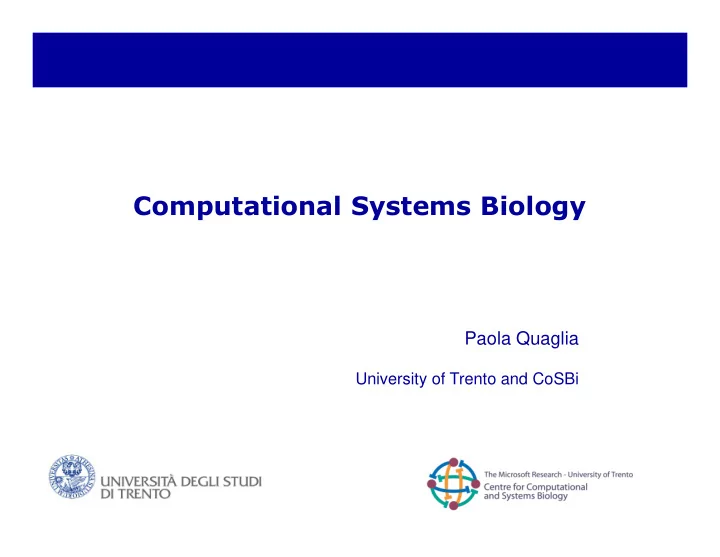

Computational�Systems�Biology Paola Quaglia University of Trento and CoSBi
Agenda Deterministic�chemical�kinetics • Stochastic�chemical�kinetics • Simulation:�Gillespie’s�direct�method Simulation:�Gillespie’s�direct�method • • BlenX:�a�language�for�modelling�system�dynamics�with�a� • stochastic�run$time�support�for�simulation Plant�Bioinformatics,�Systems�and�Synthetic�Biology�Summer�School,�Nottingham,�July�2009
Chemical�kinetics:�reactions n 1 Y 1 +�...�+�n j Y j m 1 X 1 +�...�+�m k X k Plant�Bioinformatics,�Systems�and�Synthetic�Biology�Summer�School,�Nottingham,�July�2009
Reactions:�terminology Reactants n 1 Y 1 +�...�+�n j Y j m 1 X 1 +�...�+�m k X k Plant�Bioinformatics,�Systems�and�Synthetic�Biology�Summer�School,�Nottingham,�July�2009
Reactions:�terminology Reactants Products n 1 Y 1 +�...�+�n j Y j m 1 X 1 +�...�+�m k X k Plant�Bioinformatics,�Systems�and�Synthetic�Biology�Summer�School,�Nottingham,�July�2009
Reactions:�terminology Reactants Products n 1 Y 1 +�...�+�n j Y j m 1 X 1 +�...�+�m k X k Stoichiometries Plant�Bioinformatics,�Systems�and�Synthetic�Biology�Summer�School,�Nottingham,�July�2009
Deterministic�approach Assume�we�have: a�well$stirred�and�fixed�volume�V�in�thermal�equilibrium; • N�chemical�species,�each�with�an�initial�number�of� • molecules; M�reactions�through�which�the�species�can�interact. • General�question: General�question: Which�will�be�the�population�levels�of�species�after�a�period�of� time? The�deterministic�approach�assumes�that�the�number�of� molecules�of�the�i$th�species�at�time�t�can�be�represented� by�a�continuous�function�X i (t): dX i /dt�=�f(X 1 (t),�...,�X N (t)) Plant�Bioinformatics,�Systems�and�Synthetic�Biology�Summer�School,�Nottingham,�July�2009
Example Lotka*Volterra�prey*predator�eco*system Y 2Y Y�+�R 2R R Ø Y�represents�the�pre Y ,�and�R�the�predato R 1. prey�reproduction 2. predator�reproduction,�favoured�by�feeding�on�preys 3. predator�natural�death� Plant�Bioinformatics,�Systems�and�Synthetic�Biology�Summer�School,�Nottingham,�July�2009
Deterministic�formulation Deterministic�formulation: Time�evolution�is�a�wholly�predictable�process,�governed�by�a set�of�coupled�ODEs. In�many�cases�time�evolution�can�be�treated�as�a deterministic and� continuous process�with�an�acceptable degree�of�accuracy,�however:� Deterministic�modelling�of�a�biological�system�requires�the� • precise�knowledge�of�molecular�dynamics�(precise�position� and�velocity�of�each�molecule).�At�higher�level�(when�less� details�are�known),�the�evolution�is�intrinsically�stochastic. Time�evolution�is�not�really�a�continuous�process:� • population�levels�can�change�only�in�a�discrete�way. Plant�Bioinformatics,�Systems�and�Synthetic�Biology�Summer�School,�Nottingham,�July�2009
Stochastic�formulation Stochastic�formulation: Time�evolution�is�a� random*walk process,�governed�by�a single�stochastic�differential�equation�( ��������������� ). The�stochastic�formulation�has�a�firmer�physical�kinetic�basis� than�the�deterministic�formulation,�and�is�especially�relevant when�dealing�with�low�concentrations. The�stochastic�master�equation,�though,�is�very�often mathematically�intractable. Plant�Bioinformatics,�Systems�and�Synthetic�Biology�Summer�School,�Nottingham,�July�2009
Gillespie’s�Direct�Method It�is�a�computational�method�(an�algorithm)�which�takes explicit�account�of�the�fact�that�time�evolution�of�spatially homogeneous�systems�is�a� discrete (vs.�continuous) stochastic (vs.�deterministic)�process�and�offers�an applicable�alternative�to�the�solution�of�the�master�equation. References: D.�T.�Gillespie,�J.�Comput.�Phys.,�vol.�22,�1976. • D.�T.�Gillespie,�J.�Physical�Chemistry,�vol.�81,�1977. • Plant�Bioinformatics,�Systems�and�Synthetic�Biology�Summer�School,�Nottingham,�July�2009
Gillespie’s�Direct�Method�(ctd.) The�method�is�implemented�to�answer�the General�question: If�N�species�can�interact�through�one�of�M�reactions�in�a�fixed volume,�which�will�be�the�population�levels�of�species�after�a period�of�time? The�algorithm�generates�a�trajectory�of�the�evolution�of�the systems:�it�calculates� which reaction�will�occur�next�and when� it�will�occur. Plant�Bioinformatics,�Systems�and�Synthetic�Biology�Summer�School,�Nottingham,�July�2009
Gillespie’s�Direct�Method�(ctd.) Underlying�physics: reactions�are�collisions • molecules�are�randomly�and�uniformly�distributed�in�the� • volume�(assuming�the�system�be�in�thermal�equilibrium) From�this�Gillespie�argues�that,�although�one�cannot�rigorously compute�the�number�of�collisions�occurring�in�V�between compute�the�number�of�collisions�occurring�in�V�between molecules�of�two�given�species,�it�is�possible�to�precisely compute�the�probability�of�such�collision�occurring�in�any infinitesimal�time�interval. Then�the�key�point�of�the�method�is: using� ���������������������������������� instead�of ��������������� Plant�Bioinformatics,�Systems�and�Synthetic�Biology�Summer�School,�Nottingham,�July�2009
Gillespie’s�Direct�Method�(ctd.) Given�M�reactions�R 1 ,�...,�R M ,�there�exist�M�constants,�which� only�depend�on�the�physical�properties�of�the�involved� molecules�and�on�the�temperature�of�the�system,�such�that: c j dt�=� average probability�that�a�particular�combination of�R j� reactants�will�react�in�the�next�infinitesimal time�interval�dt. Why�“average”?� h j =�number�of�distinct�R j molecular�reactant�combinations�in�V� at�time�t. c j h j� dt is�the�probability�that�an�R j reaction�will�occur�in the�next�infinitesimal�time�interval�(t,�t�+�dt). Plant�Bioinformatics,�Systems�and�Synthetic�Biology�Summer�School,�Nottingham,�July�2009
Gillespie’s�Direct�Method�(ctd.) Computing�h j is�not�hard: ����������������������� Y����������...������������������� Y����������...������������������� h�=�|Y| h�=�|Y| ����������������������� X�+�Y�����������...������������ h�=�|X|�|Y| 2�X����������...�������������������� h�=�|X|�(|X|$1)/2 Plant�Bioinformatics,�Systems�and�Synthetic�Biology�Summer�School,�Nottingham,�July�2009
Gillespie’s�Direct�Method�(ctd.) At�time�T,�what�we�need�to�know�to�implement�the�next simulation�step�is: when�the�next�reaction�will�occur, • which�kind�of�reaction�it�will�be. • This�is�a�probabilistic�information�given�by: P (t,j)�dt�=� probability�that�at�time�t�the�next�reaction�will� be�a�R j� reaction�and�will�occur�in�the infinitesimal�interval�(T+t,T+t+dt) =���� P (t,j)�dt�=�a j exp($a 0 t)��������(t�≥�0) where� a j =�c j� h j and�a 0 =� Σ j=1..M a j Plant�Bioinformatics,�Systems�and�Synthetic�Biology�Summer�School,�Nottingham,�July�2009
Simulation algorithm Initialization (set the values c j and the population levels) Compute a 0 = Σ j=1..M a j Generate two random numbers n 1 ,n 2 in [0,1] and compute t = (1/a 0 ) ln (1/n 1 ) • j such that Σ k=1.. j -1 a j < n 2 a 0 ≤ Σ k=1.. j a j • Adjust population levels according to R j and set T=T+ t then iterate from step 2
Recommend
More recommend